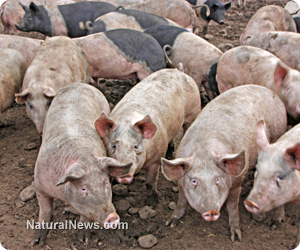Monday, February 17, 2014 by: J. D. Heyes
NaturalNews) Americans have been conditioned to believe a great many things, especially when it comes to our diet, so suffice it to say that, when tidbits of truth seep out about some of our most common foods, especially on sites like Natural News, it can be a bit of a jolt to the psyche.
Take "skim" milk. Please.
I know, old joke. But seriously, at one time it was anything but the wholesome, lower-calorie food that it is sold as today, as excerpted from the book, Pure and Modern Milk: An Environmental History Since 1900, by Kendra Smith-Howard (hat tip Slate):
Do you prefer the lighter flavor of skim milk to 1 percent, 2 percent, or whole? Before World War II, skim milk - a byproduct of butter processing - was not sold in stores, but either discarded or fed to chickens, hogs, and calves as a protein-rich replacement for costlier animal feed. The development of skim milk as an attractive product for sale only came about because dairy producers, emboldened by their success selling milk to Uncle Sam during World War II, seized on postwar marketing opportunities to sell what once had been hog slop to housewives and families.
The stench - and tourism - drove changes in the industry
During the 1920s, Howard writes, and before environmental regulations were put in place, rural areas with cheese factories and creameries dumped tons of dairy discharge into local streams, which tended to accumulate and rot, as you might expect.
Excess buttermilk also spilled out of creamery spouts and into adjacent fields, as well as directly into waterways.
"Ditches brimmed with whey, attracting flies and creating a stinky mess. Many creameries had no access to a city sewer. In 1930, only 17 percent of waste released by Wisconsin milk plants was treated, leaving 42,513 pounds of untreated whey, skim milk, and other byproducts to be drained into the state's waterways," writes Howard.
Now the release of skim milk and whey into streams wasn't new; however, changes in the makeup of rural economies in the 1920s and '30s, coupled with the advent of automobile-driven tourism and the Great Depression that struck rural farms especially hard, altered the manner in which industrialists came to grips with, and reacted to, pollution from milk plants.
"The increase in rural tourism during the interwar period made it more difficult for dairy plants to hide the deleterious effects of dairy manufacturing from the public eye," Howard wrote. "As the number of Americans with automobiles increased and rural roads improved, motorists sought to take invigorating outdoor adventures in the countryside. When tourists who ventured to the countryside to be energized by fresh breezes found themselves breathing the foul vapors of 'dairy air' instead, disappointment ensued."
Other uses for skim milk - airplane wings
As one manager elaborated in the 1920s:
Learn more: http://www.naturalnews.co...







